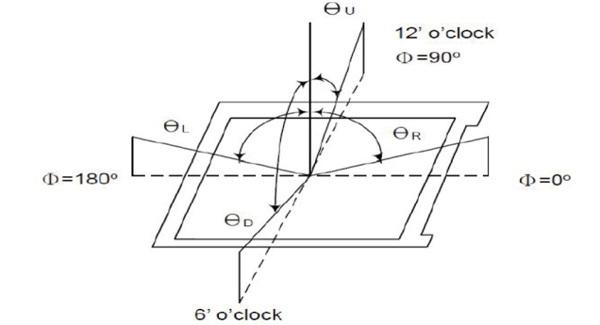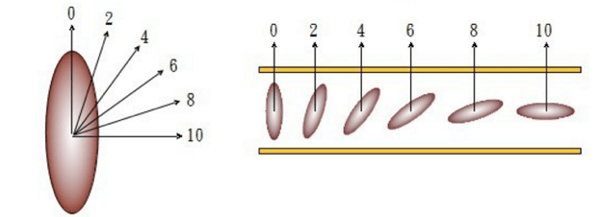When we introduced IPS in a previous article, we mentioned one of the biggest advantages was in viewing angle. In fact, there are a couple of different characteristics with respect to the direction of viewing. You may have heard of displays that boast of "Full Viewing Angles" or "Big Viewing Angle" in marketing. Today, we'll unpack some of the elements of viewing angle and viewing direction.
First off, let us look at the figure as below :
Figure 1
You may have seen something similar to Figure 1 in some LCD (Liquid Crystal Display) datasheets, so we'll explain the meaning here.
The view direction is the sight direction marked with Φ which is with respect to the X-axis. The original location is the center point of the display panel surface, the Z axis is Normal, the X-axis is Horizontal and Y-axis is Vertical.
Normally it was defined 4 angles to correspond with 3, 12, 9, and 6 o’clock respectively. So you can find the 6 o’clock or 12 o’clock parameter in the display‘s datasheet.
View Angle is the angle with respect to the Z-axis in a certain direction and marked by θ (θU means upper View Angle). View Angle describes the maximum watching angle and it is one of the key indicators with the display module.
Why does LCD have direction and angle indicator?

Figure 2
Let's touch on the optical phenomenon when the light moves across the liquid crystal molecule. It is the relational graph between light Phase Delay with direction as left of Figure 2 where zero means Phase Delay is small. The right of Figure 2 is the relationship between light Transmission Rate with direction. Ten means Transmission Rate is at maximum and at its highest brightness.

Figure 3
LCD uses light emission characteristic and control of the light brightness to form the grayscale. Based on the relationship of the light direction and the LC (Liquid Cristal molecule, same as below) direction, you can see that the left of Figure 3 shows the case if you look from a different direction. The light is parallel to LC long axis, the Phase Delay and Transmission Rate are small and it is dark if you look from below (6 o’clock).
The light is vertical to LC long axis, the Phase Delay and Transmission Rate are large and it is bright if look from above (12 o’clock). It is clear that there is a different Gray Scale from a different direction.
The right side of Figure 3 shows the Gray Scale Inversion case. When looking from a certain angle and increasing the Electrode voltage, The LC will rotate to a larger angle and It will cause the angle of light and LC are close under maximum voltage and minimum voltage. It means that the Gray Scale is the same and we can see the scene of bright becoming dark and then bright following the voltage increase.
Because the LC angle and distribution are not fully symmetric, you can see the Gray Scale Inversion from a large angle. Gray Scale Inversion will cause bad display effect.
Normally we use Contrast Ratio, Gray Scale Inversion or Color Shift to define the View Angle. The View Angle is the critical angle in which the Gray Scale Inversion does not happen if you select the Gray Scale Inversion to defined it. They are not the same definition but the result is close. So, we should not care about the definition but our requirement.
What View Angle and View Direction do we need?
Of course, the larger the viewing angle, the better. It is means that you can see a perfect image by large inclined angle without any distortion.
View Direction can determine the best view direction and avoid putting the display in the wrong place. Normally the LCD View Angle is Vertical symmetry but not up and down. If you usually look down, the 12 o’clock is suitable. Of course, the view direction os great from this angle. (no difference of UDLR).
How to mark the View Angle and View Direction?
There is another method to mark the View Angle except Figure 1. For example, 160 degree means the total angle is 160 degree for up/down or left/right direction.
Sometimes we confuse the mark of View Direction. For example, we record 45/35/65/65 sort by U/D/L/R, someone says it is 6 o’clock (point out the Gray Scale Inversion direction), but another one says that it is 12 o’clock. So It is necessary to check in the datasheet to confirm the detail if you get a new display module. In one thought, the bigger angle is the best direction we should look at the screen from. From this, we can select the proper screen for our application.
In the end, that's why all of this matters. For some applications, the viewing direction of the screen might be different from others. So, it's very important to understand how the display will be used and what environment it will serve in. Characteristics like viewing angle and viewing direction become important differentiators, in the end, only if they match the final use case.
Posted by Jacen Wang

Head of Electronics Engineering @ NexPCB. Give this man a breadboard and a box of electronics and he will make magic (not to be confused with magic smoke). Almost all the Raspberry Pi's in the office are his.
